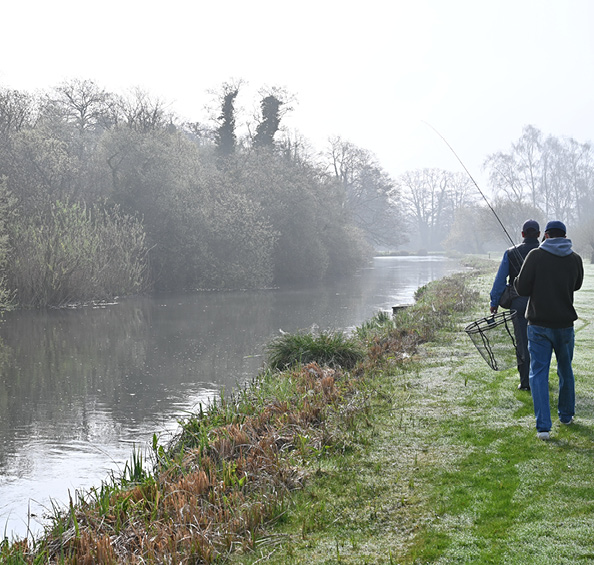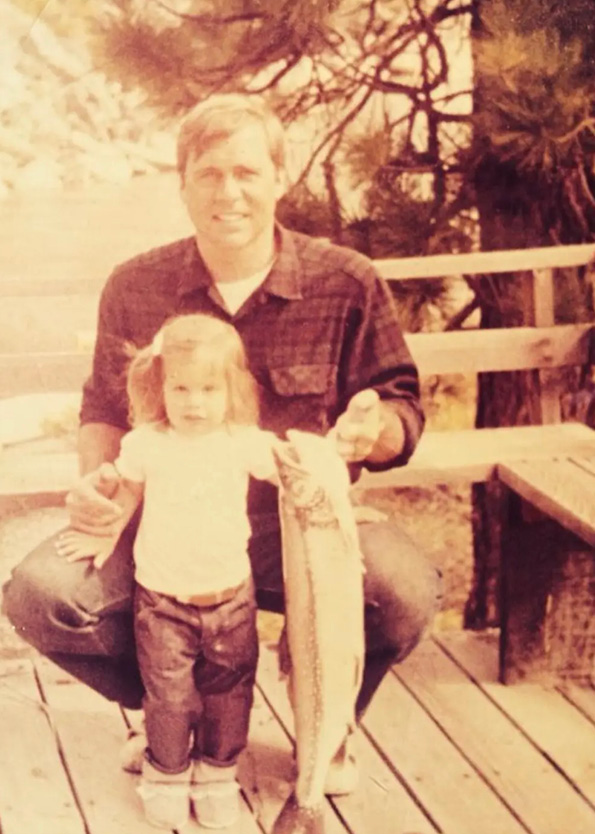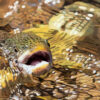Photos by Merrill Watson
Dressed in waders, Dad slipped on the mossy rocks and into shallow-yet-fast-moving Burney Creek.He’d taken one step towards me to help with a snarled line and went down instantly. Eight-year-old meimagined him careening through the rapids with a final and fatal cascade over Burney Falls and into the icypool 120 feet below. Fortunately, the worst that happened was his waders filled with water, he didn’t catch any fish and my own line remained tangled in overhanging Douglas fir.
Mostly, our summer vacations involved fly fishing ona remote river or lake in California. One epic trip involved riding horses into the wilds near Mount Whitney in search ofthe state freshwater fish, Oncorhynchus mykiss aqua bonita, better known as California golden trout, a species so beautiful that it has a wilderness named after it. We even fished Chuck Yeager’s favorite beat. The renowned pilot didn’t seem too excited to encounter four noisy teenagers clambering along the rocks by the creek when he thought he was alone, all those miles in. Like Yeager, Dad found an escape fly fishing in the back country, even with us tagging along. Through fishing we learned about nature, how to read a river, how to tie a fly on and how to gut a fish. We even learned a Watson family secret: rubbing the joints of the rod in the crease of our noses to help lubricate the connection. When I had my own children, I was keen to continue the traditions, create memories and teach the same skills. I took my son JP on our first fishing trip when he was a boy. Not knowing much about fishing in England, I turned to Orvis, which owns beautiful stretches on famous chalk streams—the Test and the Itchen. That first trip was a bit ambitious on my part; expecting a five-year-old to spend the
day on the bank quietly stalking fish was crazy. We did take home one big brown trout that we smoked, but the real success of the trip was the beginning of JP’s love of the sport. It remains one of his fondest childhood memories. We have fished periodically over the years, but the times we spend together now are more sporadic. When I decided to write about chalk stream fishing for The Virginia Sportsman, I thought it would be a great opportunity to connect with JP on the river. The best part is that his girlfriend Ayamé fly fishes too and fished the Test when she was five. Fortunately, they both jumped at the chance to go. We returned to Stockbridge and the White Hart Inn, the same small town and pub we visited 14 years ago. Stockbridge, a village of thatched houses, pretty churches and country pubs, lies in the Test Valley of Hampshire in southern England. The Test flows through Stockbridge, considered the birthplace of modern fly fishing and the sport’s Mecca. The Test rises from springs in a chalk bedrock creating clear waters with less seasonal variation than other rivers
The vein of chalk stretches as far as the White Cliffs of Dover, but in Wessex it has created a perfect ecology for trout and salmon. We checked into the pub and enjoyed a great dinner. Surrounded by fly-fishing ephemerae and hearty locals, we reminisced about previous trips and headed to bed early for a good start in the morning. After a full English breakfast, we met our guide, or ghillie, Adam Sinclair of HATCH Fly Fishing, on the Ginger Beer beat, Orvis’ private stretch on the Test. Early in the season, the water, although smooth and glassy, was slightly high and not warm enough for a good hatch; the popular mayfly season was still weeks off. Add fog to the mix, and visibility was tough. But Sinclair remained confident and assured us we would have a good day. Sinclair has been a ghillie for eight years and spent 26years in the British army. After a “gruesome” tour in Iraq, an army friend took him fishing to help him find respite from his demons. That day he discovered calm—and a ton of fish. “I was hooked,” he said, and being in nature casting and concentrating kept his mind off the horrors of war.
Since then, he has been working with the armed forces using fly fishing as an alternative means to address PTSD.
Looking at the smooth flow of the River Test, I began to relax too. It was already turning out to be a wonderful day.
After discussing tactics, selecting flies and exchanging competitive jibes, we headed down the grassy bank and flushed a pheasant on the way. Sinclair suggested we begin at the bottom of the beat and work our way upriver to stay behind the fish.
We started with a Red Tag Nymph. It was chilly, so a wet fly was the best option for the morning as a dry fly without a hatch might be suspicious to the ever-wily brown trout, our primary target. We found our spots on the river, and, after a short refresher from Sinclair, started casting. Everyone was a little rusty, and the casts weren’t that smooth, but soon we found a rhythm.
A roll cast was perfect for getting the fly out into the middle of the river. I heard the first cuckoo of the year, always a marker that winter has gone and a good omen for me. I am a fair-weather angler and was happy when the fog cleared and the temperature warmed. Sunshine also made it easier to see fish.
“I’ve got one on,” Ayamé said after her third cast. The fish got away and left a bent fly in its wake. It must have been a brute.
Excitement waned but competitive determination returned as JP hooked a big brown trout minutes later. JP was determined to keep his on the line after witnessing Ayamé lose her fish. After a little bit of back and forth, he landed his fish. I took photos, and my son released his prize.










Suddenly, Ayamé hooked an enormous rainbow. With patience and skill, she brought her fish to Sinclair’s net too. Ayamé’s smile was as wide as her fish was long.
We took three more rainbows—and hooked twice an equal number of tree branches, which brought back memories. The fishing slowed and we headed back to Stockbridge for lunch and retail therapy at Robjent’s. JP and Ayamé emerged with new fishing hats, perfect for collecting the winning flies of the day.
Back on the river, the fish were still not biting. We tried different flies: Yellow Humpy, an Olive; Pheasant Tail Nymphs; a Duracell and a Hare’s Grub. Ayamé hooked a grayling, which has a characteristic red dorsal fin resembling a sail. Anglers call the fish the “lady of the stream.”
“I get corporate people out here using their phones the whole time,” said Sinclair, appreciating our focus. “One guy spent time in the fishing cabin on his laptop.”
What a wasted opportunity, I thought. Our day would have been shorter if we only cared about catching fish. We enjoyed the tranquility and the beauty of the stream. Ayamé claimed catching a big trout was her favorite part of the day. She smiled with a competitive grin, then said, “I enjoyed the sun and the birds too.”
We caught three more rainbows. JP caught a grayling. Then we spotted something different on the river—a pike with a brown trout in its mouth.
“It looks like a dog with a bone,” Ayamé said.
When I booked our trip to share an experience with my son and recreate memories, I had no idea how the day would turn out. We caught fish and lost others. We laughed regardless. Our main takeaway was gaining a greater appreciation of the restorative power of nature through fly fishing. That was the lesson Dad wanted to teach me long ago.
Thanks, Dad.
For more information, visit sportingadventures@orvis.co.uk and hatchflyfishing@outlook.com.
Merrill Watson, a native Californian living in the English countryside, fell in love with writing while sending letters home from her hut in Senegal in the 1990s. A freelance writer, she loves to share her passions for outdoor sports, travel and art with her readers and fellow travelers on the ground during tours in England and on the African continent. For more information, contact her at mewatson@protonmail.com.
















